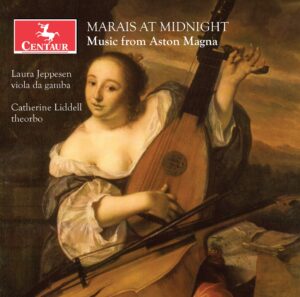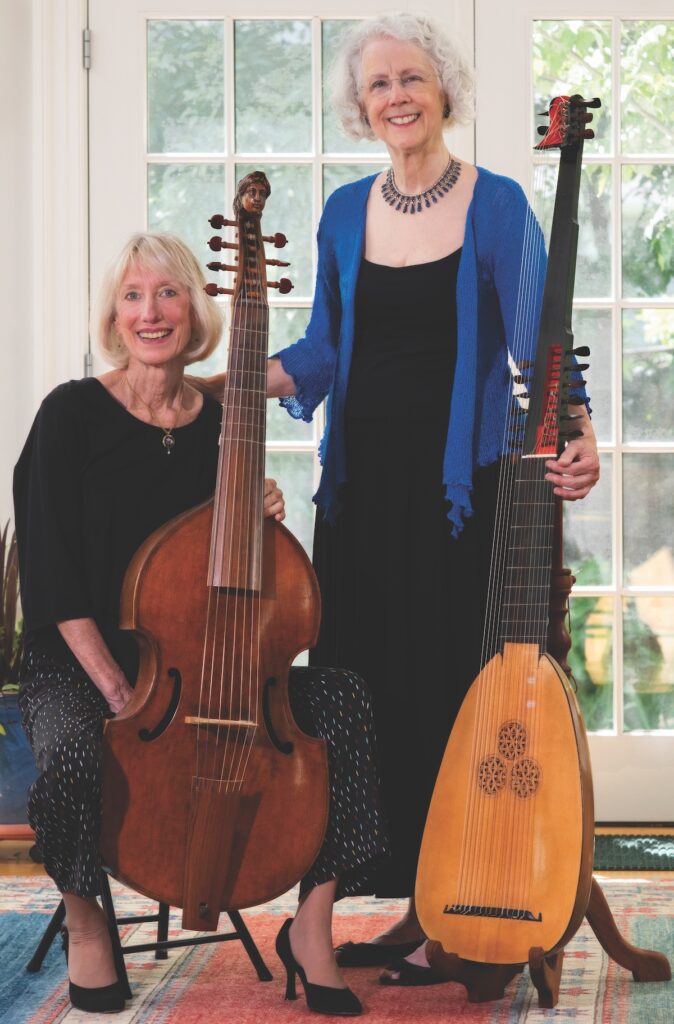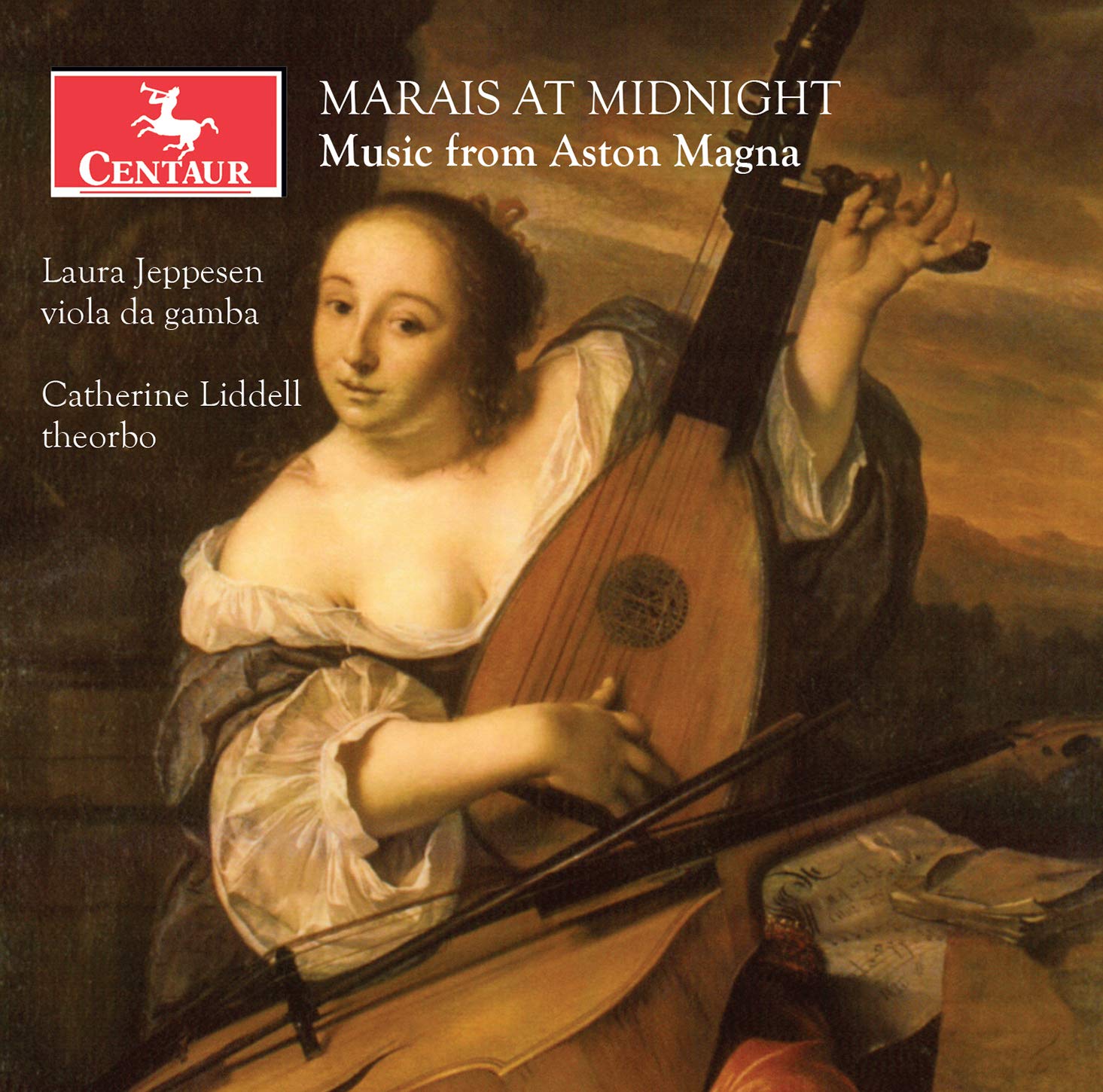Aston Magna is proud to announce a new CD release, ‘Marais at Midnight,’ with Laura Jeppesen, viola da gamba, and Catherine Liddell, theorbo, performing selections by the composer and viol player of Louis XIV’s court.
Reviewer Ken Meltzer of Fanfare magazine describes this recording as “ravishingly beautiful as well… exemplary performances by Jeppesen and theorbo player Catherine Liddell are immaculate in execution, and played with the utmost sensitivity of phrasing and tonal beauty.”
BUY CD

MARAIS Prélude en harpègement. Prélude in A minor. Suites. La Rêveuse. Le
Troilleur. La Matelotte. Sarabande à l’espagnol. La Biscayenne. Le Basque Laura
Jeppesen (viola da gamba); Catherine Liddell (theorbo) CENTAUR 3866 (64:26)
Writes reviewer Ken Meltzer
Marin Marais (1656-1728) was a composer and viol player who served and thrived in Louis XIV’s court. As gambist Laura Jeppesen observes in her liner notes for the Centaur release “Marais at Midnight: Pièces de viole by Marin Marais”, Louis XIV “had an appreciation for the viola da gamba which guaranteed its status throughout his long reign.”
Marais composed prolifically for the viola da gamba, and also entertained the King and his friends and family by concertizing on the instrument. The repertoire on “Marais at Midnight” evokes the type of concert described by Madame de Sévigné, quoted at the outset of the booklet: “those who wished, played, and those who wanted to, listened to the lovely concert given by Visée, Marais [and others]; that lasted until midnight…” The artists have chosen repertoire appropriate for such an event, here performed on viola da gamba and theorbo. As Jeppesen explains: “We imagine instead a midnight-hour petit concert in the chambers of Madame de Maintenon, the viola da gamba and theorbo bending toward each other in intimate conversation.” The works comprise three multi-movement Suites (with the traditional Prélude, followed by several dances), as well as numerous free-standing pieces. As advertised, the music is intimate in nature, and ravishingly beautiful as well. Jeppesen observes that Marais “was meticulous in notating every possible detail to convey his aesthetic, and the twenty-first century player has no greater teacher.” The exemplary performances by Jeppesen and theorbo player Catherine Liddell are immaculate in
execution, and played with the utmost sensitivity of phrasing and tonal beauty. All of this is captured in recorded sound that beautifully reproduces the atmosphere of an intimate gathering. The overall effect is quite magical, and a pleasure from start to finish. An exquisite release, one I enthusiastically recommend.

Writes reviewer Colin Clarke:
The French composer Marin Marais (1656-1728) was something of a genius. His works positively demand our attention, and while Dennis Brain might have made “La Basque” popular at one time by using it as a horn and piano encore, Marais has so much more to offer. Robert Smith’s exquisite disc of viola da gamba Suites on Resonus Classics has acted as sure testament to that; and now along comes Laura Jeppesen and Catherine Liddell on Centaur to help round out the picture. Titled Marais at Midnight and subtitled “Music from Aston Magna,” this disc acts as celebration of the most intimate side of Versailles; for some 40 years, King Louis XIV encouraged Marais to compose gem after gem, and what we hear is a speculative petit concert for just two instruments. I am assuming the “Aston Magna” refers to the US festival of that name. The players chose pieces that suited this combination, sans keyboard, carefully. The result is beautiful in the extreme. The Sarabande from the C-Major Suite is a pure example of that sublimity; the Courante that follows is the epitome of gallanterie. The use of viola da gamba and theorbo gives this music a sense of otherworldliness that, alongside with revealing the music’s inherent dignity, is little short of revelatory. It is clear much thought has gone into the realization of Marais’ scores, and the two players play as one, with an almost telepathic rapport. Technically, everything is impeccable (how bad tuning could ruin this repertoire; and how profound it appears in sterling performances such as these). This is music of great character (try the relatively famous “La Matelotte,” from the E-Minor Suite from Book Four of the Pièces de Viol, or the viol-plus-tapping “La Biscayenne”).
We hear that “La Basque” here, too, the registral differences of those octave drops at the end of the principal phrase more marked on viola da gamba than on horn (and I like the way Jeppesen emphasizes that aspect), too). Fascinating to note that Marais was so fastidious in his notation as regards the thorny subject of ornamentation; his scores therefore function as textbooks of sorts, too. Marais’ melodic contours are negotiated with real understanding by Laura Jeppesen. The program cleverly presents the music as three “Suites” with three additional short movements; the recording supports the intimacy of the music and performances. Regarding the booklet notes to this release, I do wonder whether Centaur is going for some sort of prize for the smallest font size? It is tiny, and if I were not reviewing, I simply would not bother. That said, this remains an absolutely outstanding release.
Writes reviewer Michael De Sapio:
This disc is titled Marais at Midnight and is an outgrowth of the early-music festival Aston Magna, held
summers in western Massachusetts. Viola da gambist Laura Jeppesen and lutenist Catherine Liddell are regulars at
the festival and both have decades of experience as exponents of Baroque repertoire. Jeppesen in her liner note
explains the idea behind this recital: “Our intent in choosing to record these pieces on our intimate instruments, viola
da gamba and theorbo, is to draw the listener not only into the innermost sanctum of the court of Versailles, but into
the innermost region of [King Louis XIV’s] heart.” Marais’ short dance movements for gamba and figured bass are
arranged here in three suites with an unpredictable flow of movements. Although we encounter the conventional
Baroque dance types, there are a few special character pieces strewn about as well, with such titles as Les Voix
humaines, Plainte, La Rêveuse (“the dreamer”) and Saillie du café (which would appear to mean either “the café
ledge” or “a café witticism”) Whatever the meaning, this is exquisite music and exquisitely performed. With musicians as proven as these we can be sure of being in good hands. Jeppesen’s way with the viol is more expressive and characterful as
well as fuller of tone and more varied of color than one often hears. She executes perfectly the Marais’s minutely
notated ornaments, including a special fluttering vibrato. Everything is gloriously light, never the least bit labored, not even the multiple-stopped chords. Her love and affection for the music come through. Liddell’s playing on the theorbo is flexible yet well-projected, and it is most pleasing to hear the airy effect of these two instruments together. The recorded presence of the musicians is just right, and this makes for a very pleasant early-music concert.

